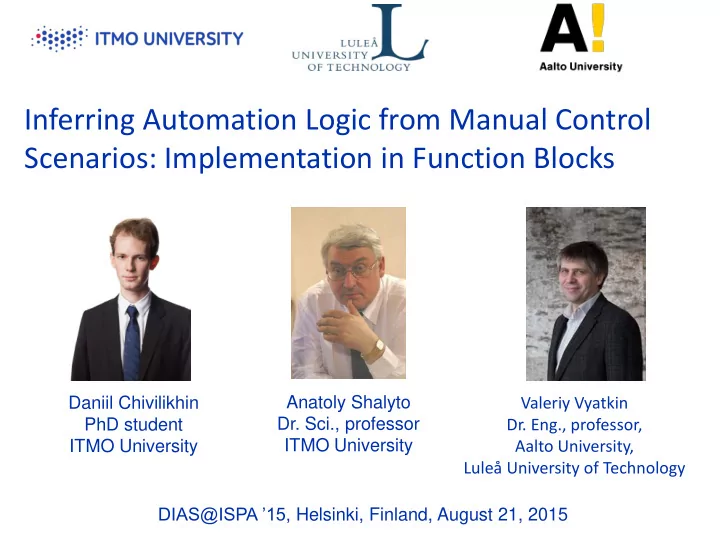

Inferring Automation Logic from Manual Control Scenarios: Implementation in Function Blocks Anatoly Shalyto Daniil Chivilikhin Valeriy Vyatkin Dr. Sci., professor Dr. Eng., professor, PhD student ITMO University ITMO University Aalto University, Luleå University of Technology DIAS@ISPA ’15, Helsinki, Finland, August 21, 2015
MVC application engineering 1. View 3. Controller use to debug 2. Model 2/33
MVC application engineering 1. View 4. Controller 3. Automated controller use to debug generation 2. Model 3/33
Problem statement Develop a method for automated controller generation for MVC applications 4/33
Implementation: IEC 61499 function blocks Function block interface Execution Control Chart (ECC) 5/33
IEC 61499 Execution Control Chart states 6/33
IEC 61499 Execution Control Chart Guard conditions Boolean formulas input/output variables internal variables constants 7/33
IEC 61499 Execution Control Chart Algorithms Change output variables 8/33
Assumptions and simplifications Model and View are implemented Only Boolean input/output variables Guard conditions – only input variables 9/33
Proposed approach 10/33
HMI generation M.I: Model’s inputs that should be set by Controller M.O: Model’s outputs to be used in controller 11/33
Refactored MVC scheme 12
Execution scenario s 0 s 1 s 2 s 3 s 4 s 5 Input Input Output Output event variables variables event REQ 01011010 101010 CNF 13/33
Recording execution scenarios Dummy function block Automated refactoring 14/33
ECC construction algorithm: previous work Metaheuristic algorithm • Chivilikhin et al. Reconstruction of Function Block Logic using Metaheuristic Algorithm: Initial Explorations / In Proceedings of the 13th IEEE International Conference on Industrial Informatics (INDIN'15) No theoretical bounds on running time In one special case we can do better! 15/33
Exact ECC construction If each algorithm is used in exactly one state We can determine algorithms automatically And then construct the ECC + only for Boolean inputs/outputs! 16/33
Proposed ECC construction algorithm 1. Determine minimal set of state algorithms 2. Construct ECC from scenarios labeled by found algorithms 3. Simplify ECC 17/33
Algorithm representation Algorithms are strings Example over {‘0’, ‘1’, ‘ x’ } z 0 1 1 0 a i =‘0’: set z i =0 a i =‘1’: set z i =1 a x 1 0 1 a i =‘ x’ : preserve value of z i a(z) 0 1 0 1 18/33
Determine initial set of simple algorithms For each scenario s and each Example pair of elements s i and s i+1 s i 0 1 0 1 Calculate algorithm a for transforming s i → s i+1 s i+1 0 1 1 0 Function calcAlg( s i ,s i+1 ) a x x 1 0 j j x , if s s ; i i 1 j j a 0 , if s 1 s 0 ; i i i 1 j j 1 , if s 0 s 1 . i i 1 19/33
Determine initial set of simple algorithms 20/33
Merge algorithms Function merge(a, b) Example a a , if a b ; 0 x 1 0 j j j ab m j x , if a x b x . b j j 0 1 1 x m ab 0 x 1 x 21/33
Only consistent algorithms are merged Algorithms are consistent if they don’t have contradicting elements 0 x 1 0 contradiction 1 1 1 x 22/33
Checking if merge is valid Invariant : algorithms A’ ← A \ {a, b} are sufficient to A’ ← A’ U { m ab } represent all scenarios if A’ satisfies invariant For each scenario s then A ← A’ For each s i and s i+1 a A : applyAlg ( a , s . out ) s . out i i 1 23/33
Merging algorithms: pseudocode Try to merge each pair of algorithms Until no more merges can be made 24/33
Constructing ECC using found algorithms 25/33
Constructing ECC using found algorithms 26/33
Simplifying ECC Constructed ECCs are redundant Each guard depends on all input variables 6 -> 5 ["REQ [c1Home & !c1End & vcEnd & !pp2]"]; 6 -> 5 ["REQ [vcEnd]"]; 6 -> 5 ["REQ [c1Home & !c1End & vcEnd & pp2] "]; 7 -> 0 ["REQ [vcHome & !vac]"]; 7 -> 0 ["REQ [vcHome & !vac]"]; 7 -> 3 ["REQ [vcHome & vac]"]; 7 -> 3 ["REQ [vcHome & vac]"]; 8 -> 7 ["REQ [!c2End]"]; 8 -> 7 ["REQ [!c1End & c2End]"]; 8 -> 7 ["REQ [c2End]"]; 8 - > 7 [“REQ [ c1End & !c2End]"]; 9 -> 1 ["REQ [c2End]"]; 8 -> 7 ["REQ [c1End & c2End]"]; 9 - > 1 [“REQ [c2End & vcHome & !vac]"]; 27/33
Experiments: Pick-n-Place manipulator 28/33
Experiment setup 10 tests: order of work piece deployment • 1, 1-2, 2-3, 1-2-3, 2, 2-1, 2-3, 3-2, 3-2-1 29/33
Experiment protocol Record scenarios Construct ECC Convert to Java & compile Simulate in FBDK 30/33
Results Proposed method constructs the ECC in less than a minute Previous method required ~ 4.5 hours on 16-core machine Simulation showed that the ECC works correctly 31/33
Limitations & Future work Approach is only useful if manual control is easier than designing the ECC User bears all responsibility for scenario correctness and completeness What about generalizing ? • Consider temporal properties 32/33
Acknowledgements This work was financially supported by the Government of Russian Federation, Grant 074-U01. 33/33
Thank you for your attention! rain.ifmo.ru/~chivdan
Recommend
More recommend